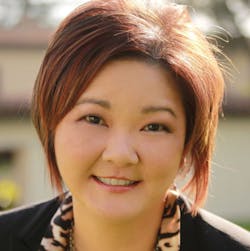By Susan Quan, MBA, MPH, RDH
On my first day of dental hygiene school in 1986, my class of 32 students sat nervously in an auditorium at the University of Texas. Juanita “Nita” Wallace, PhD, RDH, our program director, was about to give the welcome message. She entered the room in a way that inspired respect and awe. Her message was simple: “With all that you do in your profession, always put your patients’ interest first, and every other aspect of your career will fall into place.”
It was not until the end of my program that I would truly learn this lesson. As a student, I studied well and scaled teeth with passion. But up until that point, I’d never put anyone else before me—I was young. Meeting the clinical requirements for graduation was tough, as any dental hygiene student can attest. The pressures mounted, I fell behind, and I struggled to complete my clinical requirements for graduation. This led to lapses in clinical judgment, and I began “squeezing in” patients to meet the requirements, which led to stress and anxiety.
© Krittiraj Adchasai | Dreamstime.com
Four days before graduation, I was summoned to Dr. Wallace’s office. I was informed that I was not eligible to graduate and would be held back one semester. I was shocked. My family had already flown into town to watch my commencement. I had several job offers waiting for me. My life was shattered into a million pieces. I cried and begged to no avail. It was determined that, even though I had technically met the clinical requirements, I had not learned the most important lesson of all.
Dr. Wallace asked me if I remembered her message from my first day of school. In the rawness of the moment, I couldn’t. She reminded me that if I put the patients’ interests first, then everything else would fall into place. I was informed that, in my hurried clinical practice over the previous few weeks, I had lost sight of why I chose to do certain procedures and merely found bodies to put in the chair to work on. It was the graduation committee’s decision to hold me back one semester, during which I would work under the direct supervision of a dedicated faculty member. She was not only going to be grading my clinical work but also developing my professional skills. I spent that summer feeling upset and resentful.
Looking back, that makeup semester comprised the most valuable learning in my 28-year career. Under the mentorship of a dedicated faculty member, I had long discussions about clinical judgment and decision making. I also had the opportunity to mentor freshman and sophomore students. These skills continue to shape my practice today. Putting the patient’s needs first in every clinical decision has given purpose to my job—Dr. Wallace’s ultimate lesson.
Whether you’re a seasoned professional or a new graduate, it is critical to periodically reflect on our purpose in this profession. The challenges that plague our profession today—the unsatisfactory wages, the perceived disrespect for our role in the dental practice, the physical toll—are very disheartening and can make us lose sight of our purpose. As educators and advocates, dental hygienists are in a unique position to make a huge impact on the health of each patient we see. This article provides a strategy for defining and evaluating our purpose, so we can make a huge impact each day we show up to work.
In a recent informal poll, I asked dental hygienists why they entered the profession, and only 100 out of 519 respondents (19%) indicated that they entered the profession to help people.The other replies were about matters of self-interest, such as needing a higher challenge after dental assisting, income potential, and landing in this profession after trying other things. These matters of self-interest are short-term. When this kind of goal is met, it can leave us seeking the next level of satisfaction. Even worse, if the goal is not met, we are left frustrated and unhappy. Focusing on the needs of others brings a higher, more sustainable level of satisfaction, which in turn will lead to personal rewards and career longevity. But how do we make this happen?
Start with the “why?” In his book Start with Why, renowned author and speaker Simon Sinek asserts that if people don’t buy why you do something, they are not likely to buy what you do.1 In other words, have a purpose. Furthermore, in health care, it is not enough simply to have a purpose. Having a purpose defined by putting others before ourselves is almost a requirement for success. When patients in our care leave better than they were when they arrived, this is a success that everyone in the office can feel. It is human nature to dislike selfishness and self-centeredness. Placing patients’ interests before our own makes self-interest impossible. It also makes our purpose sustainable over a long career with each patient we treat.
Declare your intention. Declaring your intention is a natural part of having a purpose—it is commitment to that purpose. If our purpose is to put patients’ interests before our own, we can state howwe will practice our purpose: “I will place my patients’ interests first by being their best health advocate.” We can even take this further: “I will be the most effective advocate by fully educating my patients on [insert topic here], so they can make informed decisions about their health.”
Do an internal audit. Having a purpose-driven practice requires us to frequently and deeply evaluate where we are and how we can get to the next level of practice.In other words, the process of internal audit means we need to continually redefine our goals and intentions as we grow in our profession. We are only effective at what we do if we continue to strive to perform at a higher level than where we are today. This requires us to continually ask ourselves questions, such as “How can I master this topic in order to fully educate my patients about it?” and “What other areas of growth can I take from here?”
In business terms, it’s called developing a competitive edge, or finding a way to be relevant in today’s competitive environment. Oftentimes, the answer lies in continuing education. In today’s oral-systemic paradigm of dentistry, it is not enough to simply master scaling and oral hygiene subject matters. We must now become educated on broader topics, such as cardiovascular disease, diabetes, nutrition, drug use and abuse, sleep loss, brain health, inflammation, etc.
Part of goal evaluation is knowing when our goals are actually met. Otherwise, we could be chasing an unknown outcome.
Identify obstacles and solutions. Having a vision and a goal is only a part of the journey. In every journey, obstacles hinder us from reaching our goals. For example, if we have a goal of higher daily production, obstacles might include frequent cancellations or patients’ refusal of treatment. Therefore, we must identify potential obstacles and have a strategy for addressing them.
Suppose your goal is to ask for a raise. The reasons why might include feeling overdue, increased production, or a below-market salary. You might declare your intention by asking for a meeting with your employer by a certain date. Include any research that you’ve done to support your request, such as cost-of-living or production numbers. An internal audit might involve asking yourself, “Am I justified in asking for this raise?” and “What evidence do I have to support my request?” Potential obstacles might include a perceived lack of production or financial hardship in the practice. Anticipating the obstacles and being prepared to provide solutions greatly improves the likelihood of getting that raise.
Determine if the goal is attainable and if the purpose is sustainable. Dental practices, like all businesses, must have a long-term outlook in order to survive. Dental hygienists must also adopt a long-term view of their roles. Aligning our own career goals with those of the practices we work in will help us foster better working relationships with our employers and fellow team members, contribute to our practices’ long-term goals, and give a meaningful purpose to our practice that also ensures our career longevity.
Today’s health-care environment is complex. Dental hygiene, like many other health-care services, has become commoditized. Today’s dental hygienists might find it difficult to envision a meaningful, long-term career in today’s business model of dentistry, in which Yelp reviews and production numbers can drive how we practice. While the business model of dentistry is not likely to go away anytime soon, clinicians must find ways to balance meaningful clinical practice that supports career longevity with the business pressures that drive day-to-day practice. The best way to achieve this balance is to develop a clear strategy for meaningful practice that makes you the most productive you can be by always placing patients’ interests first.
Reference
1. Sinek S. Start with Why: How Great Leaders Inspire Everyone to Take Action. New York: Penguin Group; 2009.
Susan Quan, MBA, MPH, RDH, has been a private-practice dental hygienist for 28 years and is an oral wellness therapist in a cutting-edge periodontal practice in Campbell, California. Her passions include teaching, writing, and helping to bridge the gap between dentistry and medicine through oral-systemic education.








